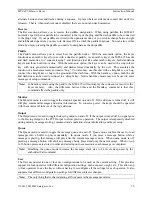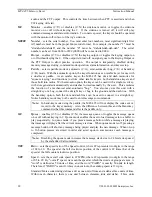
MFJ-495 Memory Keyer
Instruction Manual
©
2001-2009 MFJ Enterprises, Inc.
19
separate characters and seven units separate words. Farnsworth spacing (see above) will
increase the amount of time between characters and words. Note that setting the overall
speed greater than or equal to the Farnsworth speed will disable Farnsworth spacing.
T##
T
one – sets the sidetone frequency to approximately ##0 Hz, where ## represents two digits
in the range of 30 to 99. The MFJ-495 features smooth, clean audio, with sine wave output,
instead of the harsh square wave audio used by many other keyers. Also, the MFJ-495
produces each dit and dah with a rise and decay time of approximately 5 milliseconds,
avoiding the "spikes" that cause distracting key clicks. The MFJ-495's audio sounds like that
of a good CW transceiver.
T
T
one – sets the sidetone frequency in the range of approximately 300 to 1000 Hz. Press the
dash paddle to raise the sidetone frequency; press the dot paddle to lower. Squeeze both
paddles to exit. Notice an alternating series of dots and dashes are sent to the sidetone
monitor to assist in the setting of the desired sidetone frequency.
U#
U
ser – selects the current user, where # represents the digit 1 to 4. User mode is provided to
support four operators with different configuration settings, such as speed, weight, etc. This
allows up to four operators to use the keyer without having to reconfigure all the settings for
each operator. It also supports four different configuration settings for different contest
exchanges.
V
re
V
erse – reverses the sense of the dot and dash paddles. When using paddles, the MFJ-495
normally expects the dot paddle to be connected to the tip of the plug and the dash paddle to
be connected to the plug's ring. If your paddles are wired in the opposite manner, or you wish
to change between right and left-handed operators, you may reverse the paddles.
W####
W
eight – sets the automatic code weighting between ## percent at the counter-clockwise
position and ## percent at the clockwise position of the Speed control, where each ##
represents two digits in the range of 25 to 75. Weighting varies linearly with the overall
speed (automatic weight). Set both ## to the same value for constant weight, where
weighting is independent of the overall speed.
Weight is the duty cycle of a continuous string of dots, where 50% for perfect code. A higher
weight produces a heavier sound and a lower weight causes characters to sound lighter.
Weight can be set to remain constant and independent of speed, or it can be set to vary with
the code speed.
X
X
mit (carrier tune) – gives continuous key-down for adjusting transmitter or antenna tuner.
Tap either paddle to exit and release the key line.
Y
Pulse tune – gives continuous adjustable pulses for adjusting transmitter or antenna tuner.
Press F1 and F2 buttons to change the speed in the range of 50 to 99 WPM. Press F3 and F4
buttons to change the weight (duty cycle) in the range of 1% to 35%. Tap either paddle to
exit and release the key line.
Z###
Z
eros and nines – sets the way zeros and nines in the serial number are sent. The first # sets
whether to send the leading zeros as "0", "O", "T" or not at all by setting # to "N". The
second # sets whether the other zeros are sent as "0", "O" or "T". The last # sets whether the
nines are sent as "9" or "N". For example, "ZO09" will send the leading zeros as "O" (dah-
dah-dah), the other zeros as "0" (dah-dah-dah-dah-dah), and the nines as "9" (dah-dah-dah-
dah-dit).






























